We develop a gluttonous olive baguette and goats cheese habit in San Pedro and when we make our early morning escape, freshly baked loaves are secured to the handlebars and an extra large slab of cheese slowly sweats in the rising temperature. A departure from ‘civilisation’ demands packing in a few treats you won’t be seeing for a while. The cheese doesn’t make it through the day, but food will be generally tightly rationed for the next week while we tackle the legendary (seemingly among only a handful of people) Paso Socompa – One of what will likely be a few crossings of the Andes as we hopscotch our way south down Chile and Argentina.
A meandering and less than thrilling first few days is saved by the fact we are overjoyed to be on the road south again. This marks the resumption of our route to Patagonia, having spent the last three months riding in circles (though they were some excellent circles) and waiting for some Andean passes to open. The heat isn’t unbearable, and we have to concede the flat roads that might usually bore are quite the treat after our Sairecabur (mis)adventure of the last few days.
The charm of Paso Socompa lies in its remoteness and faded glory. Once the primary crossing of the Andes in this area for both road and rail, it’s now almost deserted. These days the pass is closed to motorised traffic (cyclists and hikers only, who are few and far between) and though an infrequent freight train has resumed service, the stations along the route were long ago abandoned. The bigger stations are whole clusters of falling-down structures from different eras that hint at more lively times. They make for great diversions, shelters and exploring.
Crossing the Socompa border is a delight like no other border crossing. The whole experience and place feel almost absurd. We’re greeted by some barking dogs that rouse the carabineros (police) then waste no time in pissing on Andy’s bike. They sulk around looking extremely guilty about it while he tries to figure out which water bottle is leaking. In one building, in a row of otherwise abandoned structures, there are six Chileans in full uniform with weapons strapped to their legs who begin to process our passports. I like to imagine they were hanging out in their man cave out the back then had to hastily suit up for our arrival (Andy got to see behind the scenes while filling up our bottles, indeed it was all enormous sofas and a large screen tv playing football). Being used to more efficient and clinical border crossings we struggle to contain our amusement by what ensues. All sorts of things are transcribed, photocopied, stamped and five of them take turns to weigh in on the process. I ask when the last tourist passed through and they have to think for a while before deciding… last year? Yeah, it must have been last year… It’s no wonder then that the process is savoured for an hour and a half. When we check to see if we’re done they implore us to wait just a little longer – a few photos are needed to commemorate the occasion – before they send us on our merry way with an armload of biscuits. High in sugar, fat and calories state the warning signs on the packaging. Pretty much what we live on these days.
On the Argentine side just two casually dressed fellas deftly go through the formalities with far less fanfare, though it turns out they accidentally stamped my passport with an exit stamp instead of entrance. There are hints of an offer of a place to crash for the night but unfortunately it’s early in the day and we need to push on. We’ve heard rumours of their fine hospitality including hot meals, hot showers and warm beds.
Once in Argentina the scenery is stunning, vast and colourful. Well, colourful within a muted rainbow of greys and browns. Like your eyes adjusting to the dark, you become attuned to the subtleties of the Puna’s beauty. It’s also insanely windy and the featureless, broad, sweeping lines of the landscape create few places to find shelter. Camping in the Puna is not about great views or morning sun, the only goal is wind protection and tent preservation. Often this means the tent door, usually oriented for best views, faces straight into a rock wall, if you’re lucky enough to find one.
We face our windiest day on the way to one of the main old train stations, Estación Caipe, and this tent site borders on the ridiculous – within 4 walls and a roof, the tent is fully guyed out with bikes and breeze blocks, with the winds raging all around us through door frames and long-ago blown out windows. After dark when we’re all tucked up, people arrive and are surprised to see our tent in ‘their’ spot. I can’t imagine what might bring others here, arriving after dark, but of course it turns out to be other cyclists battling the wind – three Argentine guys attempting to climb the summit of Volcán Socompa (6200m) and approaching on bikes. They made it to the pass, but were forced to turn back from the climb on realising they didn’t have enough food for the summit attempt.
Gusts relentlessly crack like thunder all night and I lie awake making deals with the wind gods. I ponder alternative routes to our planned one that continues through the barren and harsh Puna, ones with tailwinds, and maybe a few vineyards for good measure, wouldn’t that be nice? Mmmm… wine. We’re in the land of wine and steak and cowboys, but you wouldn’t know it in the nothingness out here. Daylight arrives and the wind has failed to wear itself out. Reluctantly we ready ourselves for the final dash to Tolar Grande, the first town in six days, and all of its delights. To be fair it isn’t overflowing with them, but our needs are pretty simple these days. A few vegetables, a box of cheap wine and a hot shower are plenty to keep spirits high and legs pedalling.

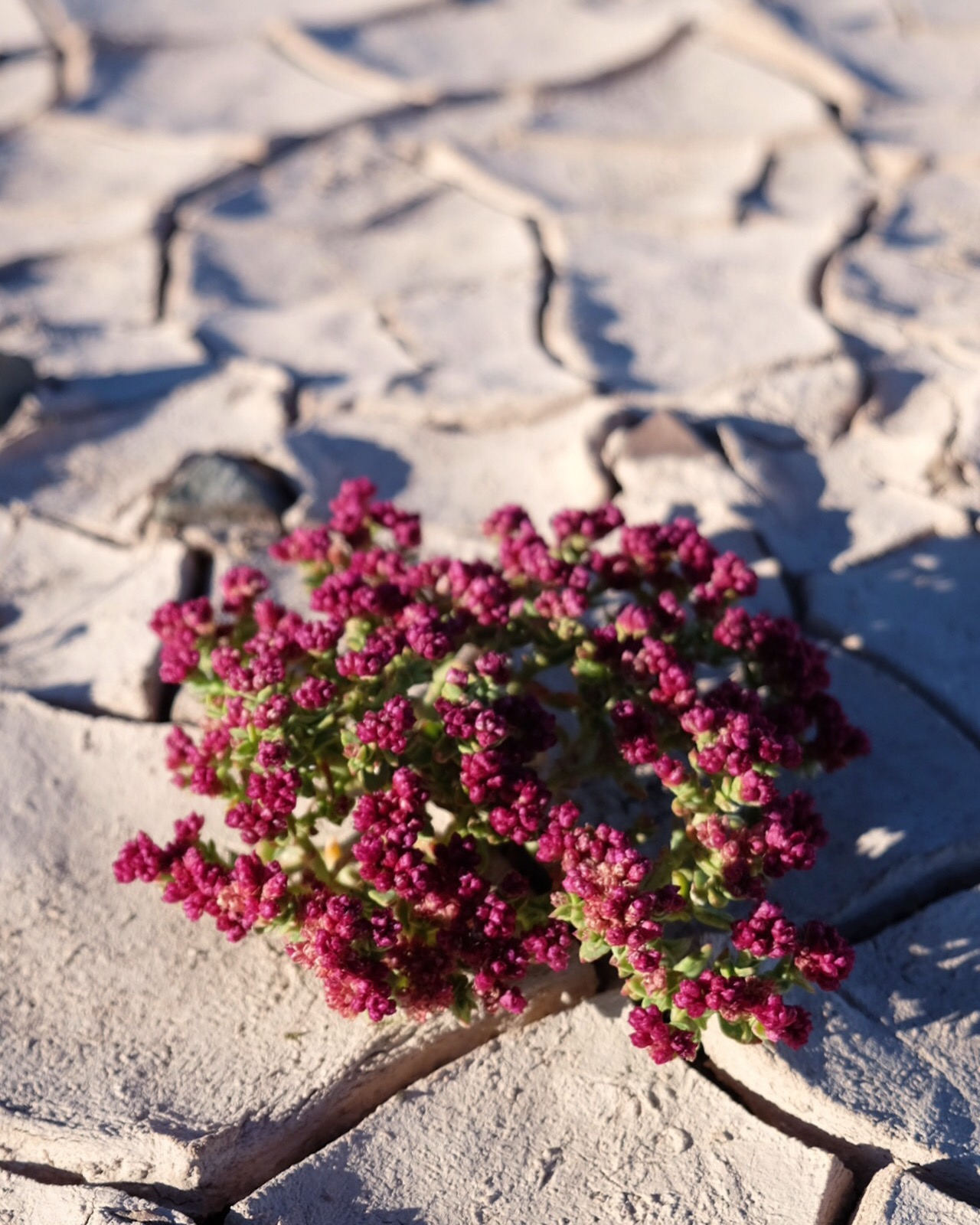 Fauna and flora of the Atacama desert
Fauna and flora of the Atacama desert
 Peine’s local football field
Peine’s local football field

 Train track relics and shortcuts
Train track relics and shortcuts
 A water carrying hack Andy devised in San Pedro using a 50c bracket from the hardware store and some cable ties. With these extra ledges and straps I can carry 4 bottles on my forks, about 5 litres.
A water carrying hack Andy devised in San Pedro using a 50c bracket from the hardware store and some cable ties. With these extra ledges and straps I can carry 4 bottles on my forks, about 5 litres.
 Estación Monturaqui
Estación Monturaqui
 Not keen to take chances with water we decided not to rely on the well at the old Estación Monturaqui, though it seemed the safest bet on the Chilean side. Luckily we hauled enough with us, as when we went to check it out the fresh carcass of a vicuña lay draped with its eyeless head on the edge, body afloat, a fox tearing at the flesh of its neck.
Not keen to take chances with water we decided not to rely on the well at the old Estación Monturaqui, though it seemed the safest bet on the Chilean side. Luckily we hauled enough with us, as when we went to check it out the fresh carcass of a vicuña lay draped with its eyeless head on the edge, body afloat, a fox tearing at the flesh of its neck.
 Photo shoot with the Chilean Carabineros
Photo shoot with the Chilean Carabineros
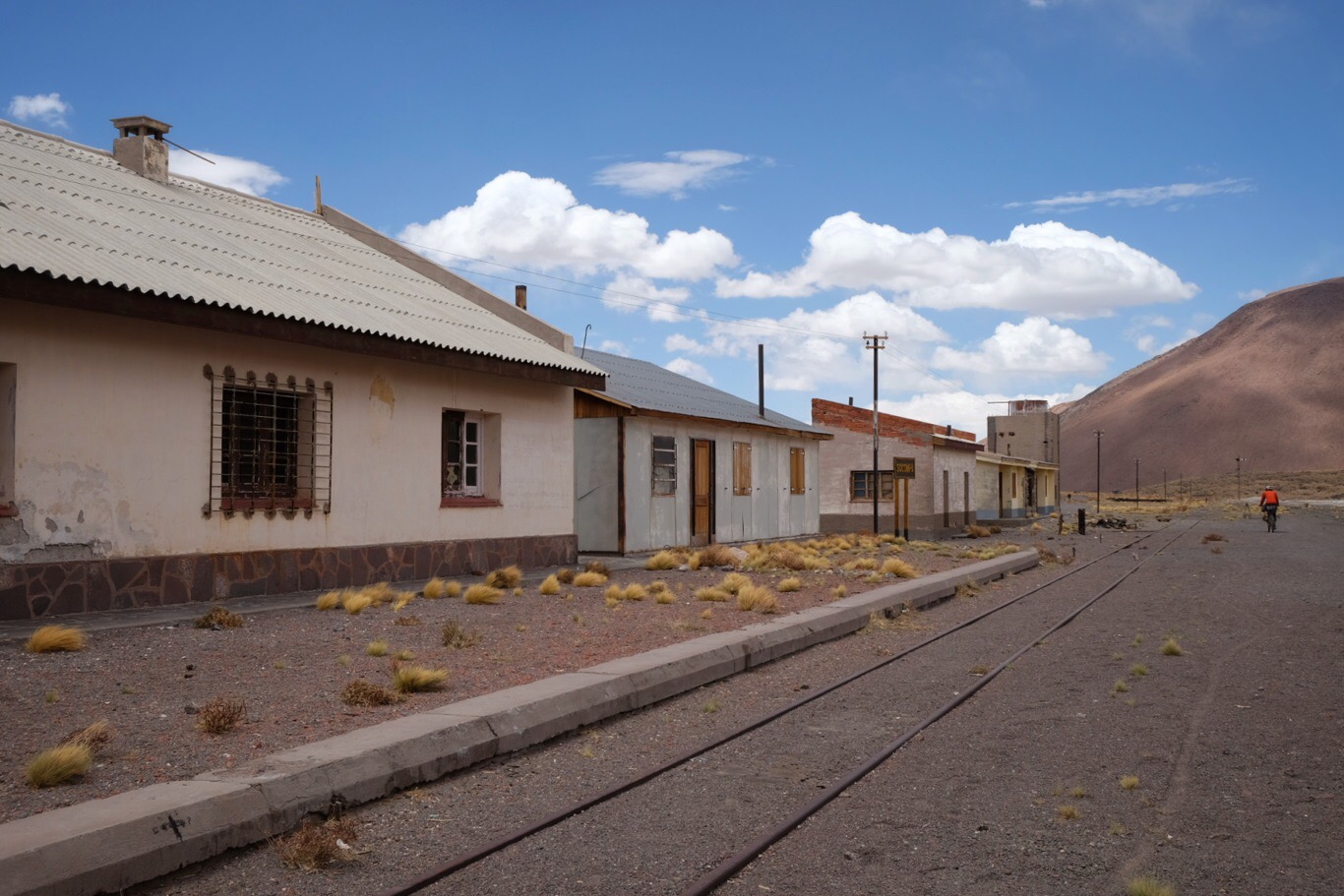 Old buildings of Estación Socompa
Old buildings of Estación Socompa
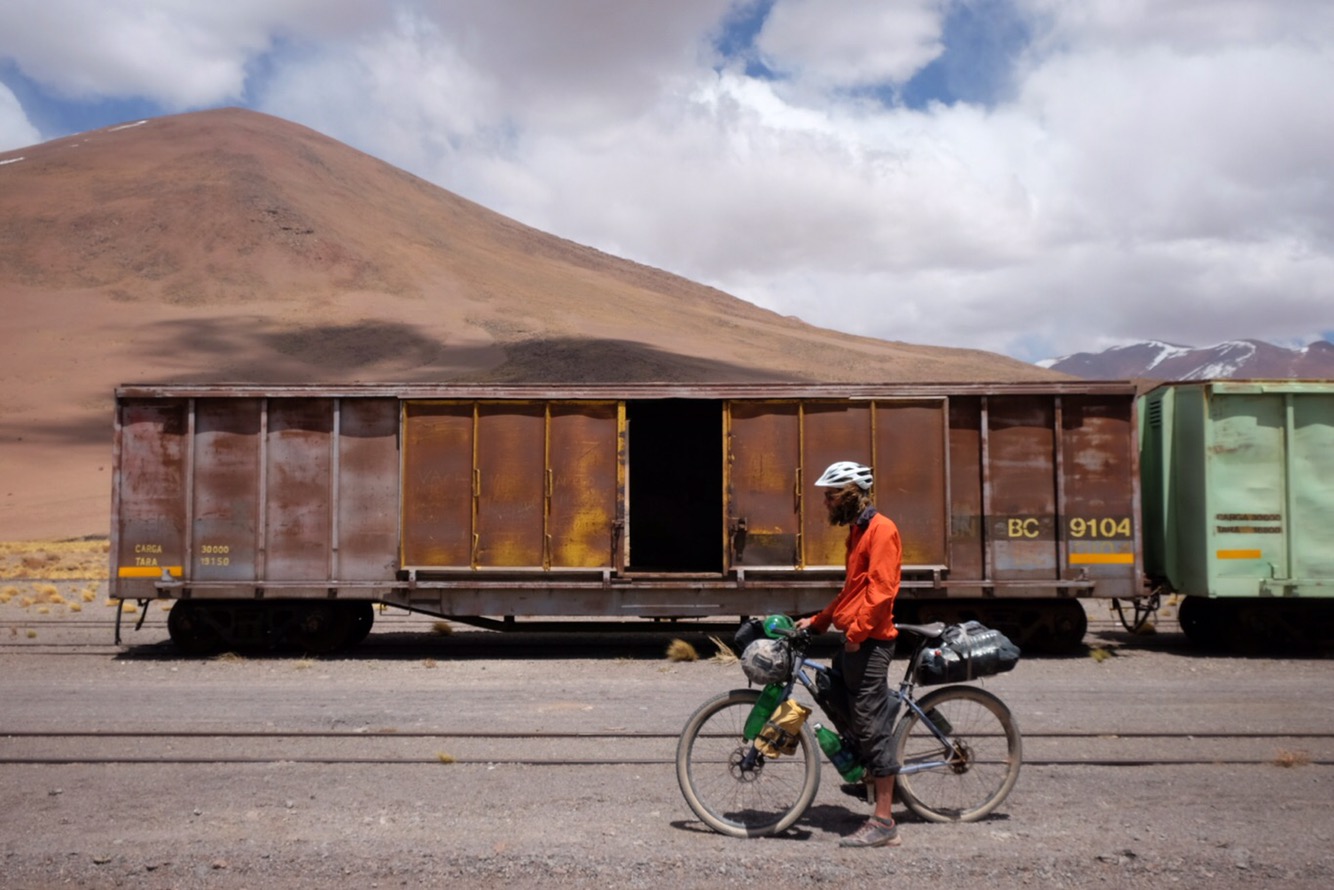
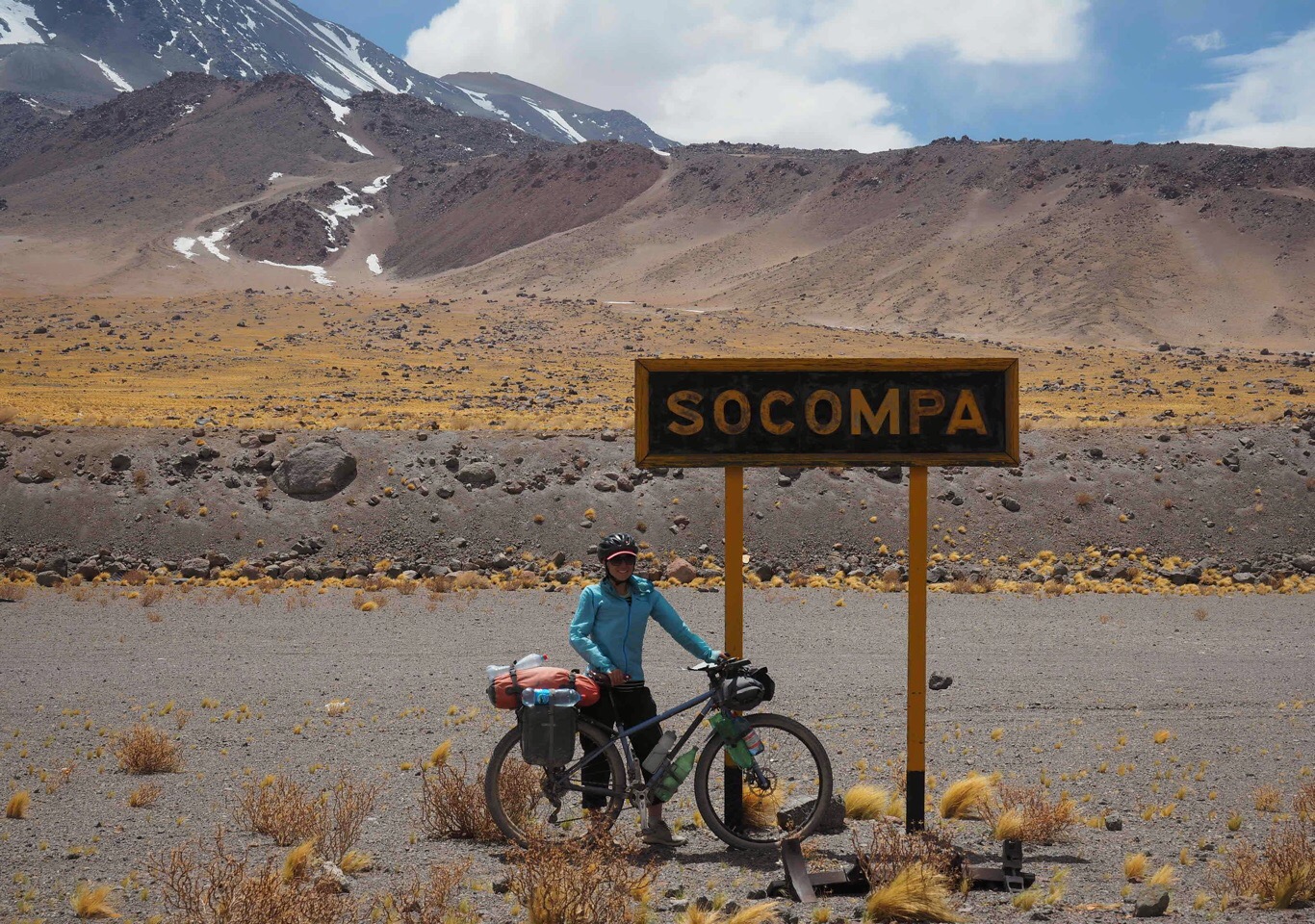 Paso Socompa posers
Paso Socompa posers
 After the prolonged border proceedings we hide behind the first rock we can find to inhale lunch and biscuits
After the prolonged border proceedings we hide behind the first rock we can find to inhale lunch and biscuits
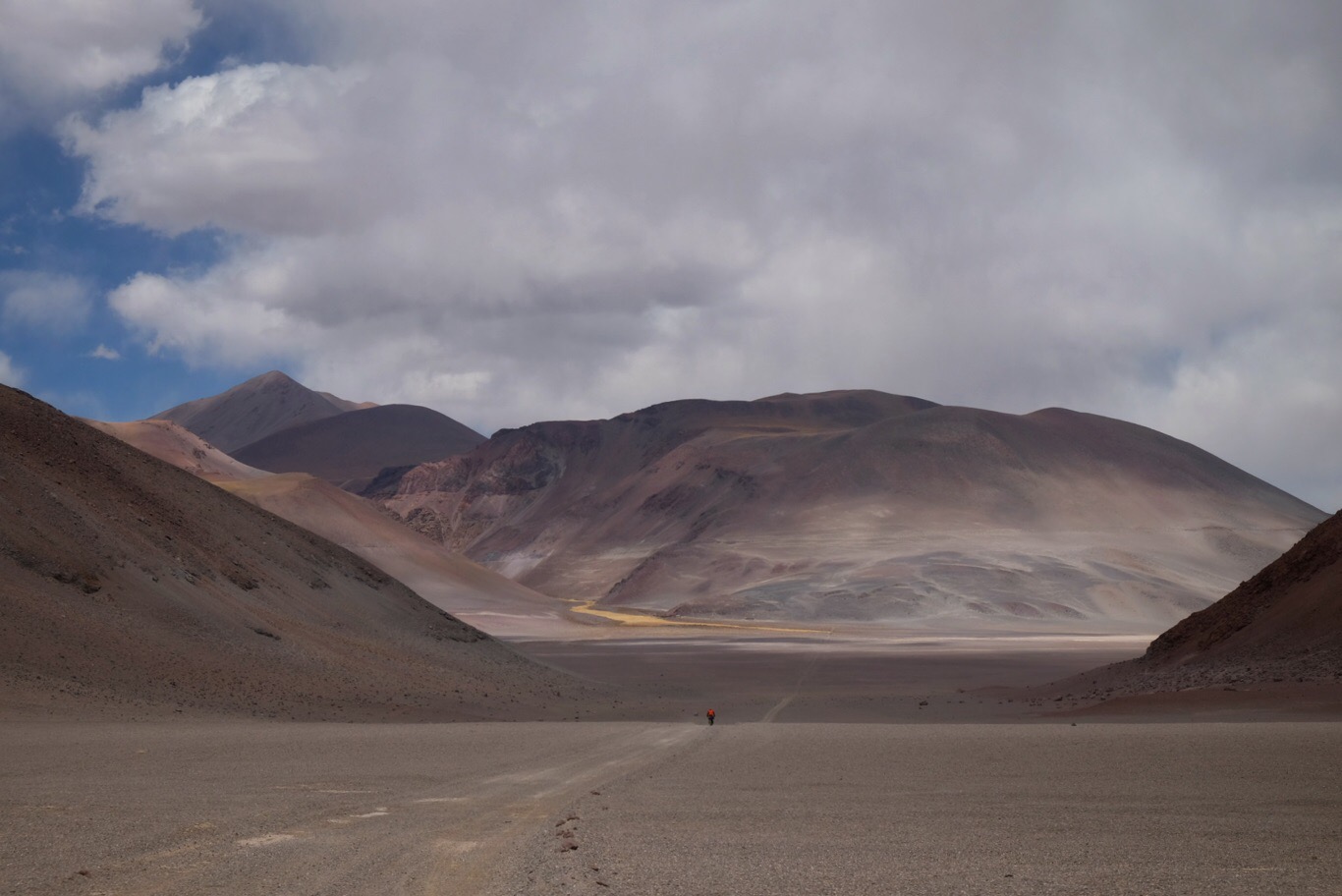 Andy hooning through some desolate Puna landscapes
Andy hooning through some desolate Puna landscapes
 Leaving behind Volcán Socompa
Leaving behind Volcán Socompa

 Biscuit bribery to get through the days last climb. Works every time. The views help too.
Biscuit bribery to get through the days last climb. Works every time. The views help too.
 Hiding places
Hiding places
 Eileen and a peeping Volcán Socompa
Eileen and a peeping Volcán Socompa

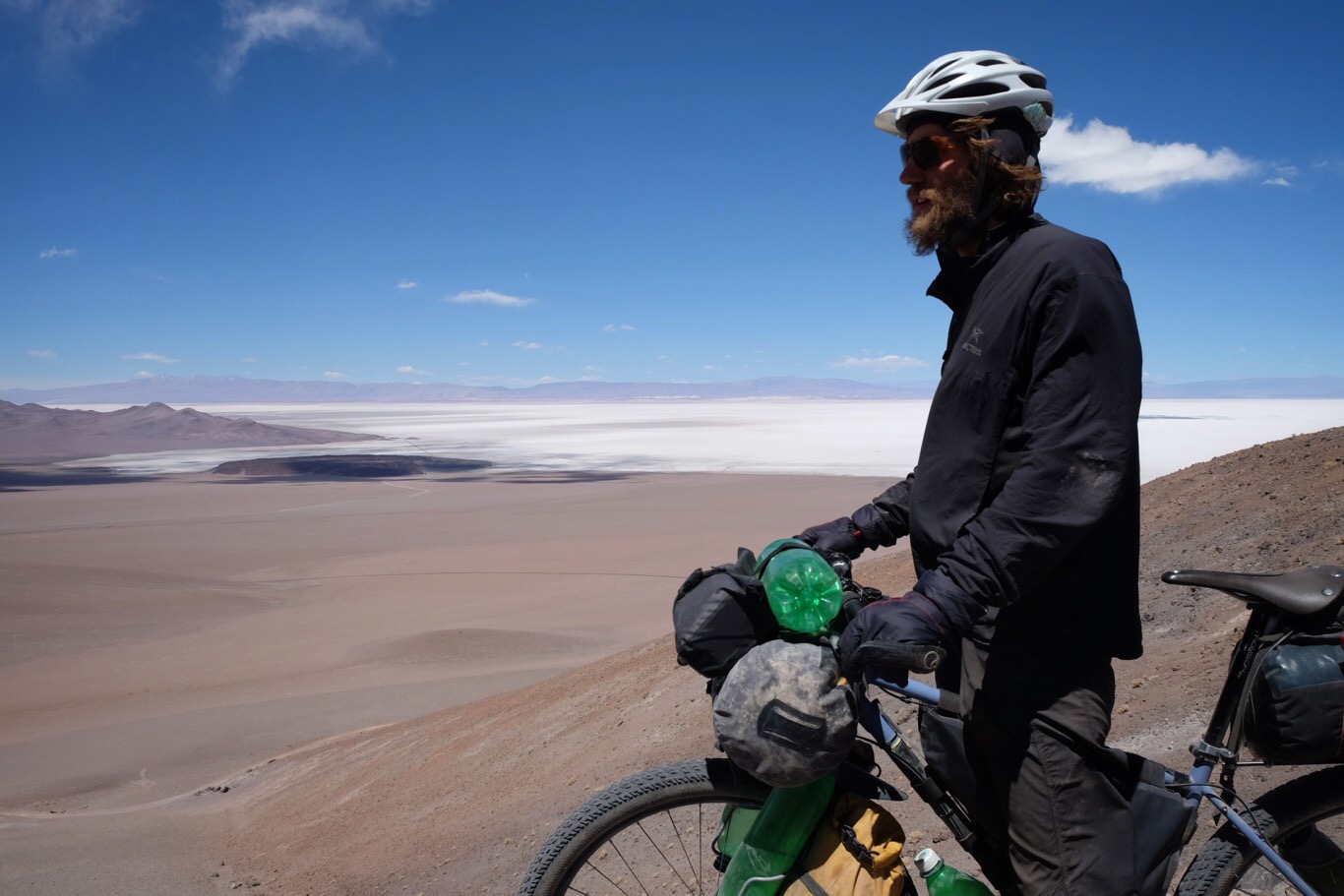 Wiggling along train tracks to Estación Caipe, overlooking Salar de Arizaro, Argentina’s largest salt flat
Wiggling along train tracks to Estación Caipe, overlooking Salar de Arizaro, Argentina’s largest salt flat

 Estación Caipe, shelter for the night
Estación Caipe, shelter for the night
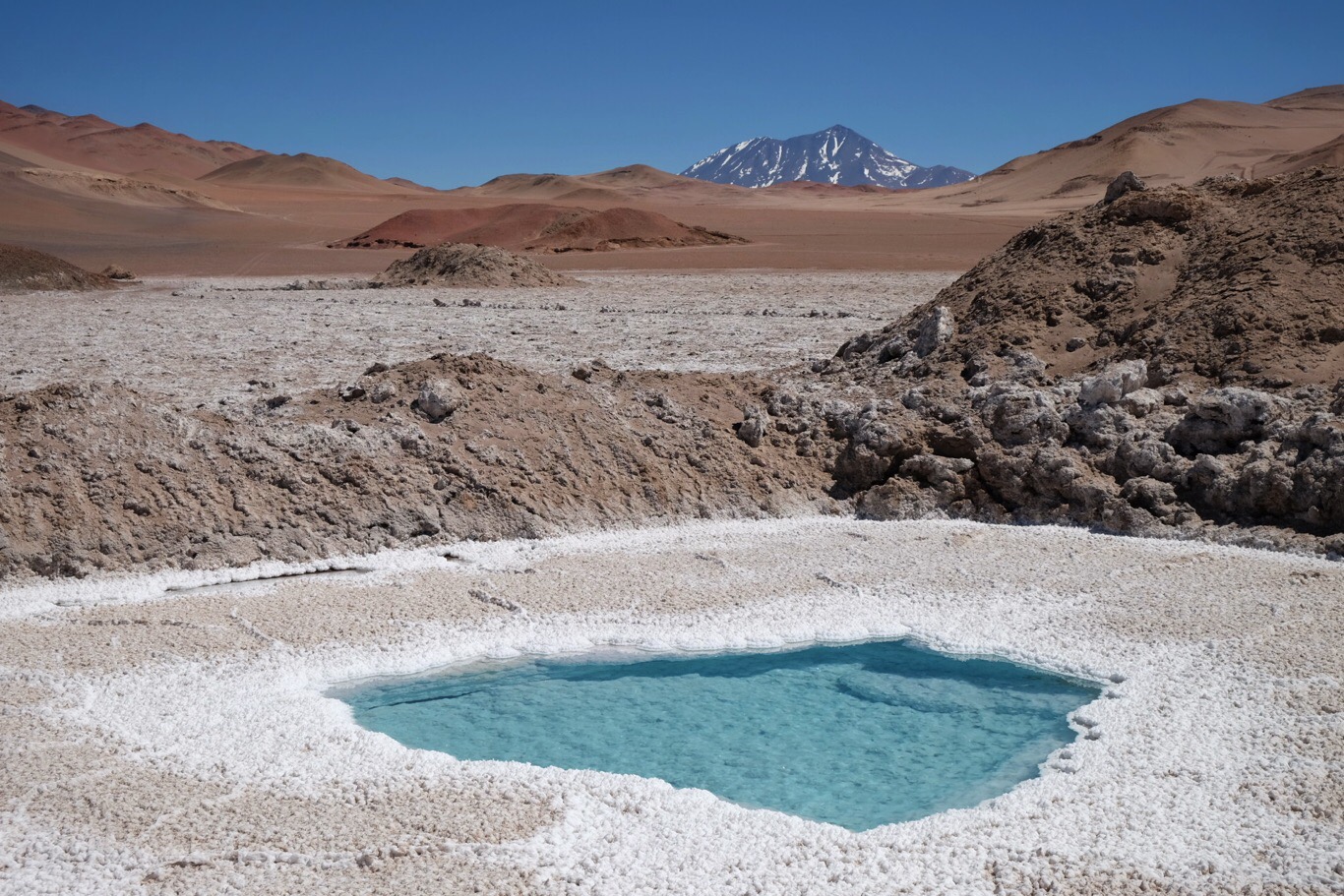 Salt-crusted, crystal clear turquoise pools are refreshing and mesmerising just to look at
Salt-crusted, crystal clear turquoise pools are refreshing and mesmerising just to look at
 Crossing the Salar de Arizaro
Crossing the Salar de Arizaro
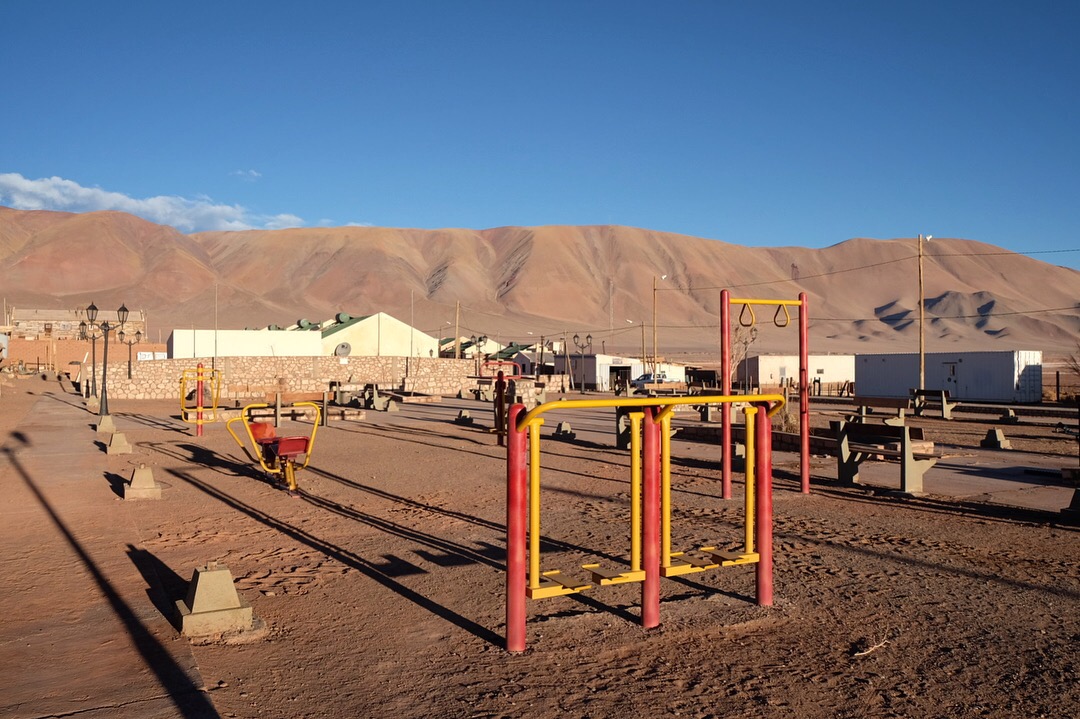
 Dusty Tolar Grande and our favourite pastime there – visiting the corner store for more food
Dusty Tolar Grande and our favourite pastime there – visiting the corner store for more food
Route notes
San Pedro de Atacama (Chile) – Tolar Grande (Argentina)
369km over 6 days, mid October
The Chileans are at the border year round, while the Argentines arrive after winter. This year it was the 14th of October. They’d initially told me it would be late October and had agreed to stamp us in in San Antonio de Los Cobres, saving us a trip to Salta. You can check the border statuses on twitter @FronterasMinSeg (they have an app too which is handy) and email the Argentine folk in San Antonio de Los Cobres on esc22-sacobres@gendarmeria.gob.ar if you want to arrange earlier entry.
The info centre, Aduanas and Carabineros in San Pedro all had differing info, if any, about Socompa, so it’s best to go direct to the source. The Carabineros however did call the border post for us.
Peine has 2 or 3 accommodation options near the top of town past the church. The trick will be finding someone. The only thing we could get was a room with bathroom for 25,000 pesos. Others may be cheaper. Shops were very basic, if even open so we’d recommend shopping in San Pedro.
Water: In Chile the pozos and water sources mentioned in some earlier blogs are all dry (a few leaky pipes around but nothing that looked reliable), with the exception of Monturaqui station 23km from the border. This was full but had a recently dead Vicuña floating in it. I’d say this reliably has water though, and is generally maintained as the Chilean Carabineros told us they get their water there.
Water at the border from either the Chileans or Argentines.
Argentine water at Estación Caipe seems reliable, worth asking before leaving the border though. One of the newer station buildings has a tap running in the back room, and the source is up the hill a bit.
Camping: Check out Nathan’s handy list of shelters. (Velo freedom link below) We had some insane wind on the Argentine side. Even if it seems calm in the afternoon your best bet is to find as many walls as possible to cower within. Temperatures never dropped much below zero Celsius at night which was much warmer than we expected.
Train track shortcuts: we took the tracks from 24.164458 S 68.466328 W to a few kms before Monturaqui station, at 24.301019 S 68.453274 W. Thanks Fatcycling for the tip, which saved a bunch of climbing.
We also took the tracks for about 12km to Estación Caipe, getting on at 24.760002 S 68.036678 W. A bit soft under tyre, so it’s arguable whether it was faster. If you take either of these, be extremely careful as the train IS running, albeit infrequently. If there’s a howling wind that impairs your hearing it’s probably best to stick to the road.
Tolar Grande has a municipal hostería now charging 150pp/pn (US$8.50). Separate men’s and women’s dorms only. There are lots of homestays, costing at least double that. There are three stores and we were able to find decent supplies.
There’s a bus to Salta via San Antonio on Fridays. The return trip is on Wednesdays.
We relied on and were grateful for the following route notes. Check them out if you’re planning on riding this:
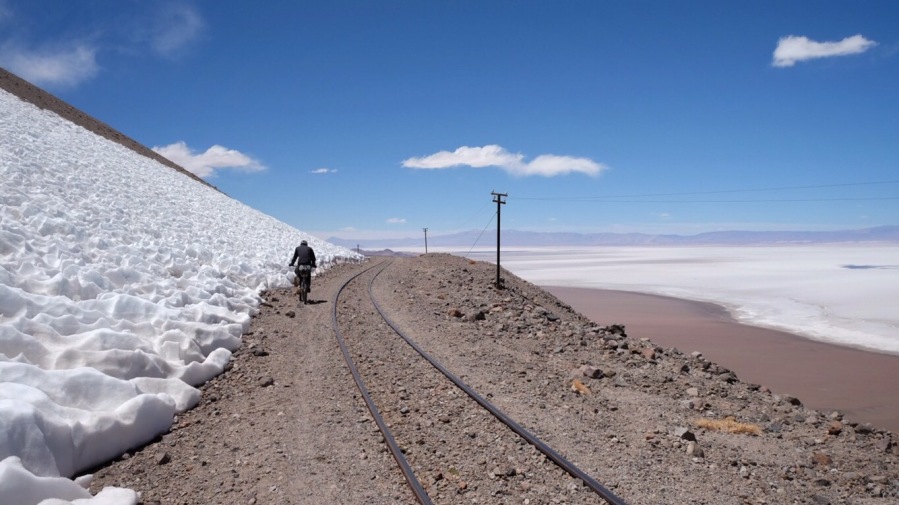

ah, envious. Great post. I loved Argentina, your words and pics make me want to get back there for a more intimate exploration. I kind of had to just ride through.. short of time, though I did sit on my arse in Salta for 10 days drinking so perhaps it’s my fault…!
Thanks Mike. And thanks for probably being the only person to read these except our parents 🙂 We’re having a great time in Argentina. The style of touring further south is so relaxing it feels like an entirely different phase of the trip. Can’t complain about all the asado, wine, ice cream and long, warm evenings. Makes it easy to while away the days and weeks for sure!
oh I’ve been sharing with a few friends. it’ll get around. I’ll give you a plug when I next do a blog post.. for some reason people read my crap. Anyway don’t stop writing because I really enjoy reading it and looking at the pics while sat here in rainy Cornwall!
oh the lower altitude does make a huge difference… and the people were invariably brilliant everywhere. I felt genuinely sad when I left Argentina for the last time.
Don’t worry your writings do get noticed by others, but you are preaching to the converted.
Now if it weren’t for the really good job I’ve got – now switched to the Rees-Dart Track – I’d jump at the chance at riding those desert blues. Oh yeah maybe you should listen to some Malian desert blues whilst riding (Tinariwen or Ali Farka Toure?).
And what about the weather, it’s summer there so shouldn’t it be the rainy season.
Also, are you always short of water, looks like you take a lot with you?
Rees-Dart, what a dream job. It’s high on our list of next hikes, just need to get down there at a less busy time.
We had no rain to speak of up there (or anywhere, so far), it’s extremely dry so I don’t imagine it ever gets much, hence all the water – we were often carrying 2-3 days worth. Sometimes we had more than we needed, if we didn’t have reliable info on water sources, but it’s not the place to take chances. Thanks for the music recs, those are completely outside my current sphere of listening!
This makes such good reading Eileen. Great for us armchair travellers! Thanks and keep it up please!!!
Thank you! You can hardly call yourself an armchair traveller though 😉
hy there!
after reading your post, i’m full of dreams and memorys!
i‘ve been in that area in early nigntees hitchhiking by truck from san pedro tu jujuy.
its something different, going on a truck than bycile riding, but it was adventourus too.
waiting three days in san pedro to get a lift, it was every day pouring rain for some hours.
yes, it was raining there!!
the passes were closed, ’cause of the danger in this kind of weather up there in the mountains.
when the road was open again, i catched a ride with a convoy of four trucks hidding to argentina.
i was very lucky, they went to a mine after hours and hours on dirt tracks, to get their load.
we arrived there in the middle of the night, after fixing a flat tyre in the ice cold darkness of the dessert.
the whole trip to jujuy was around seventy hours.
i don’know, which pass we took, but the landscape in the whole area is the greatest i’ve ever been.
some month later i took the train from salta to socompa and back.
in that times there still exist a train mixto up to there, including fraight and passengers.
4 tourists, but lots of mineros and familys on board.
from socompa to antofagasta was no passenger servis, so i took the train back to salta.
every now and than i remember that times and after a lot of traveling round south america, i belive you can’t find a more magic landscape on that continent.
high altitude mountain desert, like a water colour painting from outer space.
i love your fotos of the salar arizario, one of the most beautiful views of the trip.
we had a stop at the station too.
damn it, i should go back there in the future.
‘hanx for inspiration!
Hey there! What great adventures and memories, thanks for sharing. You must be one of few people who ever got to ride that train I imagine. The landscapes are wild and unforgettable aren’t they, they really get under your skin. I still find myself thinking about this place every other day…
Pingback: CRAW Day 129: No Crying in Argentina – Cursed & Coerced
I know its been awhile since you did this trip but wondering in which direction you headed after leaving Tolar Grande? I was hoping to find a shortcut from Tolar Grande to Salar de Pocitos and wondering if it was possible by bike. Look forward to your response. Thanks for the website.
Hey Michael, we headed back west a little the south, you can see the write up and map here: https://itsdownhillfromhere.com/2017/11/25/the-salt-road/
I think Dominik Birk mapped a route to Salar de Pocitos which is in his linked post above, but to be honest I don’t know if he ended up taking it and he was on foot. He has a bunch of links he used to research the route on that post though, so you might find some hints there. Good luck and enjoy!